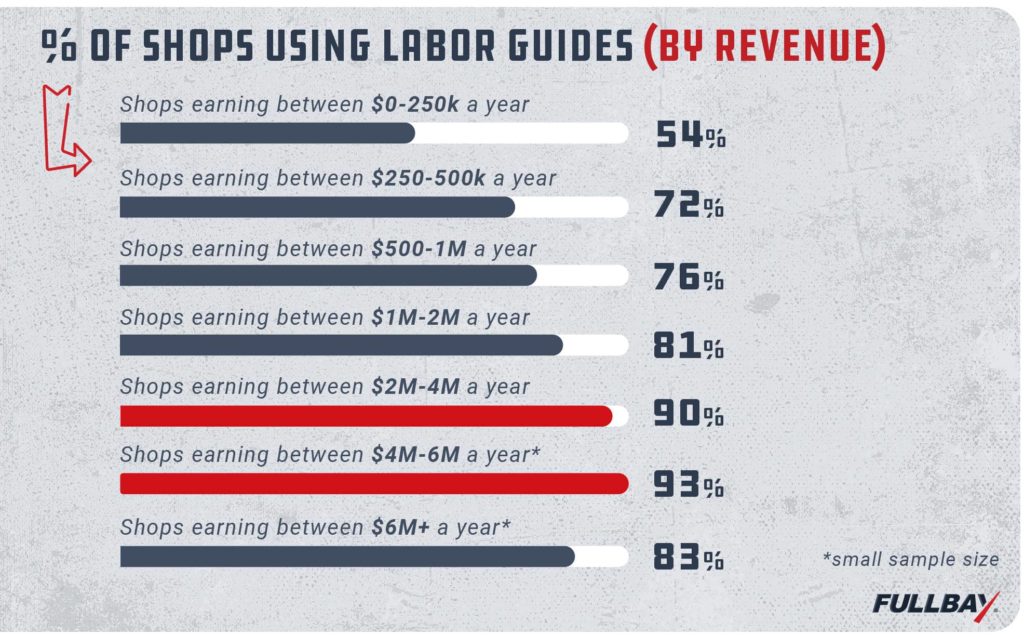Labor Guides and All That Jazz: A Deeper Dive

It’s no secret that Team Fullbay believes strongly in labor guides.
As far as we can tell, the first labor guide appeared in the early years of the twentieth century. They’ve evolved since then, though their basic purpose has remained the same: they suggest how much time should go into any given repair. Keeping one on hand, either in physical format or on an app or through a website, helps a shop ensure that they’re a) protecting their techs’ time and b) charging appropriately for it.
Full disclosure: Fullbay’s MOTOR integration gives shops easy access to an industry-leading labor guide. But we support labor guides as a whole—to the point where we actually asked about it during the data-gathering period of our 2022 State of Heavy-Duty Repair report. Nearly a quarter of the shops surveyed (23%) didn’t use a labor guide at all, which meant 77% did use some kind of guide, whether it was MOTOR, Mitchell 1, or another.
We were generally happy to see that high of a percentage (though we wish it were higher). We did start to wonder, however, how much a labor guide could help a shop be more profitable.
If you’ve been following our blog at all, then you know we collected a lot of other data that just didn’t make it into the SOHDR. We’ve been presenting this additional data over the last few weeks as a supplement to all the information in our report.
To help us interpret (and sometimes speculate on) this data, we turned to Tony Grace, CEO of ATS Fleet Services over in Michigan. He’s a strong proponent of using labor guides, viewing them as a powerful tool: “You don’t know what you don’t know,” he says. “There are people out there who can fix a truck better than anybody, but it’s always good to check and see whether you’re missing something, or something slipped by you…so you can charge more appropriately for the services you’re providing.”
Tony graciously answered some of our questions and offered thoughts of his own around the data we presented.
Ready to learn more about labor guides, who’s using them, and how they might contribute to revenue?
Let’s go!
AGE AND LABOR GUIDES
Our first question was simple: is there a particular age where repair shops go, “Dude, we totally need a labor guide” versus “Ha! We can do without.”
Here’s what the data tells us:

The most immediate takeaway is that labor guides are most popular with shops between six to 12 years of age. Use drops off once they hit thirteen, though it pops back up once they reach 20 years or more.
The dips are particularly interesting to us. Younger shops (0-5) in particular, seem like they’d benefit from a labor guide as they establish themselves and grow their businesses, so why are comparatively fewer of them putting labor guides to use?
Our crack team ruminated over this, and came up with some reasons. We also want to note that these hang-ups are applicable to a shop of any age, but may particularly factor into younger shops’ decisions:
- Budget. Labor guides do cost money, which is often tight when you’re just starting out. In addition, a newer shop might not feel comfortable passing on expenses to a customer.
- Pride. Labor guides are meant to be starting off points, not bibles, but some shop owners just think they know better than any labor guide.
- Fear. Tony concedes that there are still a lot of late adopters in the industry, people who can use a computer…sort of…but may not want to. A digital labor guide might seem like climbing Mount Everest.
- Distraction. Shop owners in general have a thousand things on their minds. New shop owners are often even more stressed. “You’re just trying to keep your head above water,” Tony says. Sometimes a labor guide just doesn’t occur to them.
We did notice a distinct uptick (7%) once a shop enters the 6-12 age bracket. This is often when operations really start to scale up their efforts, and a labor guide is particularly helpful for training new employees and maintaining consistency.
So the sudden 10% drop (to 58%!) In usage when shops reach the 13-20 age bracket is curious. It then trends back up when a shop hits age 20 (67% of shops in the bracket use them). We’re not quite sure what this means—do you have any ideas? If so, drop us a line on social media! We’re curious.
DOES A LABOR GUIDE IMPACT YOUR SHOP REVENUE?
Before we go any further, let’s make one thing abundantly clear: a labor guide alone is not going to take your shop from $250,000 to $6 million (alas!). There are many, many factors that go into high-revenue shops. Things like size, employees, customers, market, and so on all play their roles.
But we wanted to see if there was a correlation between higher revenue and labor guide usage.
Here’s what we found:

We found it interesting (and perhaps telling) that of the shops we surveyed, over 80% of the operations pulling in over $1 million per year reported using labor guides.
BENEFITS OF USING A LABOR GUIDE
By now, it’s clear that many high-earning shops turn to labor guides to help them grow and scale. Let’s look a little more into some of the ways they can benefit just about any operation.
Because labor guides give your shop a baseline to work from, they’re incredibly useful when it comes time to grow your shop. They’re also, as Tony points out, a good training tool for someone who is learning how to become a good service writer. Given the ongoing tech shortage, a lot of shop owners are having trouble hiring well-trained service writers right away. The labor guide, with its standardized times, can help new employees find their footing.
The labor guide is also a powerful way to keep shops honest with customers and themselves. Tony identified a trait in some particularly skilled technicians and owners that makes them reluctant to charge what they’re worth. The work is easy, almost instinctive for them; why demand a lot of money for it?
This phenomenon is probably related to the noble desire to not gouge customers, and we see it appear in specialists in many industries. But it’s particularly disastrous for commercial repair work, which is expensive by nature and getting pricier due to the parts shortage and inflation.
That’s a big part of why Tony appreciates a good labor guide. It keeps things realistic—and that’s important for shops and customers. “Nobody would ever logically say, ‘Well, you’ve worked a long time. You’ve become very good at what you do. You should start making less money.’”
INDIE VS. FLEET REPAIR
Our last data set focuses on independent shops versus fleet repair. The question, once again, was simple: Did one group use labor guides more than the other?
Have a look:
- 67% of indie shops used labor guides
- 68% of internal fleet shops used labor guides
Pretty darn close!
Alas, we did not pull any world-shaking information from this data. Our only real interpretation is that both groups need to use them more often.
LABOR GUIDES: A STEP TOWARD PROVIDING BETTER SERVICE
We’ve said before that a rising tide lifts all ships. By charging appropriate rates and knowing how much time should be spent on a repair, a shop can make sure it’s earning the kind of money it needs to thrive—and how efficient its technicians are.
A labor guide also provides a convenient measuring stick to see where your shop is positioned within the industry. Labor guides aren’t static; new and updated procedures are added quite frequently. Do your techs know how to make repairs on newer vehicles? Do you know how much to charge for them?
Speaking of charging, the right labor guide can even help you do some competitive analysis. Knowing what the rest of the industry is charging for a particular repair lets you see what the shop down the road or up the highway might be charging. Maybe you’re exceptionally skilled and aren’t thinking about how much you should be charging, which immediately puts you at a disadvantage if your competitors are bringing in the kind of revenue they need to grow.
That’s why we turn again to the idea that a labor guide can help keep you honest—with yourself and with the customer, certainly, but also with the industry. “The whole world keeps changing,” Tony says. “And you have to be open and receptive to the fact that there may be different dynamics. There’s certainly different technology coming. You have to be able to look around and say, ‘Am I possibly missing something?’”
In the end, a labor guide puts important information at your fingertips. We do think there’s plenty of evidence to suggest using that information can help your shop grow and increase revenue. So remember to charge appropriately and train wisely—and best of luck with your growth efforts!

